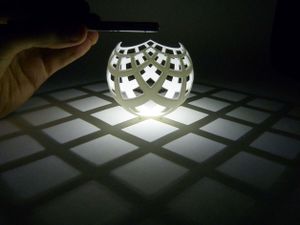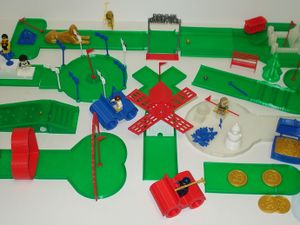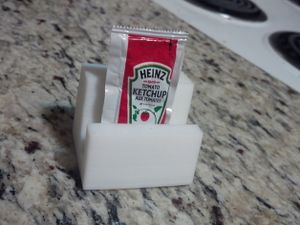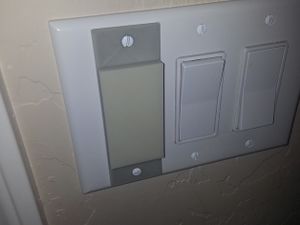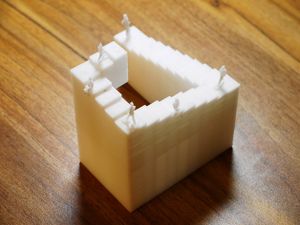User:Amfanelli/Blog
Main | About Me | Class Blog
For this class we write weekly blogs on a variety of topics that have to do with 3D printing.
Blog 1: Thingiverse
For this blog entry, we were to browse the printable objects that people have actually printed on thingiverseand find designs that are amazing/beautiful, funny or strange, useless, useful, and surprising.
Something Amazing/Beautiful
When searching on thingiverse I found this stereographic projection to be really amazing. What really amazed me about this was how much time it must have taken to design. It's also really cool that when the light is shone at the north pole of the sphere it creates a grid pattern on whatever surface it is resting on.
Something Funny or Strange
I thought this desktop mini golf course was pretty funny. The uploader added a new hole every day for 18 days until the set was complete. It's funny how much detail was put into the holes even though it would be very difficult to play. I also found it ironic that it's a desktop mini golf course but there's 18 holes (must be a big desk).
Something Useless
This ketchup packet holder was one of the most useless things I found. I've never used a ketchup packet and thought to myself "I wish there was something to hold this." The design is very simple and doesn't seem like something that would need to be 3-D printed. If you wanted to hold your ketchup packet up while using it you could just lean it against something and it would have the same affect as using this ketchup packet holder.
Something Useful
This light switch cover is something that I find to be very useful. Many times I've come across light switches that control outlets that quite frankly don't need to be controlled by a switch. In my room there is one of these switches and my currently solution is to duct tape the switch in the on position, but having a 3-D printed cover to go over the switch is a great idea. It's easily screwed on using the screws on the switch plate and could be customized to fit different styles of light switches.
Something Which Surprised Me
When scrolling through the various printable objects on thingiverse this one really caught my eye. Most people have seen the painting by M.C. Escher titled "Ascending and Descending" and this 3-D printed object is a take on the same concept. At first glance it looks as if the stairs are continuous, which was surprising because it is obviously not possible. I was intrigued with how they were able to print an object that showed this illusion in 3-D. After looking at some of the other pictures on the page it's clear that the illusion was achieved by printing a staircase with three 90 degree turns and photographing it from a specific angle. source
Blog 2: Open Source Ecology
Marcin was just here at PSU talking about his Open Source Ecology project. You may notice or suspect that 3D printers are on his list of systems which should be included in the toolkit. Respond to the following:
A) I want your general impressions of the OSE project; positive, negative, utopian, etc. Please do a bit more research than just viewing the video, as it is now several years old and they have made some progress since then. Links to more recent videos and media will earn you a better blog.
My initial reaction after watching Marcin Jakubowski’s TED talk was that Open Source Ecology is a very interesting idea. In today’s world so much emphasis in product design is put into aesthetics even though it doesn’t affect the performance of the machine. Having a more affordable machine that gets the job done without all the bells and whistles can be just as beneficial to society. Being that this project is open source these 50 initial designs could be modified to better suit the needs of the user. Just like there are many different 3-D printer models that fall under the RepRap Family Tree, there could also be many different models of the same machine within OSE.
On the OSE website I found a video detailing some of the projects Marcin and his group have completed since the TED talk was recorded in 2011. These projects include making an ironworker, more tractor models, and even a house. My only critique of the Open Source Ecology Project comes from Marcin saying that this is “essentially a civilization starter kit.” While I think that OSE is a great way for people to be able to make their own machines to run a farm at a low cost I don’t think it’s “a civilization starter kit.” In the video posted above he mentions how they built an ironworker that would normally take months to build in just 12 hours. I think these numbers are a bit misleading because I’m willing to bet that the time it took them to build it didn’t take into account the design process, or the time for the actual materials to be made. So while I think it’s a great idea and could change the way people farm in both developed and underdeveloped countries it doesn’t seem like a self-sufficient idea that would truly be a “civilization starter kit”
B) The New Yorker magazine recently had a fairly critical article regarding Marcin's OSE project. Find/link that article and summarize its critique. Marcin had a response to that: I'd like your response to both of these pieces.
The New Yorker article did not paint Marcin's OSE project in a very favorable light. The beginning of the article is very critical of Marcin's way of life almost making it seem like he lives a backward lifestyle. It seems to me that the author is trying to say that Marcin lives without the comfort's that most people in the United States are used to just to prove the point that his project works. I also believe that Marcin is going to extreme's to justify his project, which is understandable but unnecessary. The article also talks about how many people left the project causing deadlines not to be met, but the author touches on this in a way that makes Marcin seem like a difficult person to work with. At one point she mentions that one person quit over a conflict of how bricks were aligned in a wall.
Marcin's response to the article wasnt directed at the author, but was more focused on clarifying points that he thought were misrepresented in the article. Some of the things he focuses on are the Organizational Heirarchy, Financial Bootstrapping, and Self-Funding Operation. He mentions that the end goal of the project is "radically efficient, distributed production." In my opinion Marcin is trying to make production more efficient by completely starting from scratch which won't be as effective in big cities in the United States. I like his idea and think it could really be effective in underdeveloped countries, but I don't think it will catch on in the United States as more than a hobby.
C) Imagine we want to create capabilities similar to what Marcin has made at PSU (something like an OSE student club, or another effort). I don't think the administration or trustees would support such a thing, but there might be professors who are interested in supporting such a thing. Do you know any of them? What do they do, and why do you think they would be interested in such a project? Imagine you are looking for allies to do such a thing. Whom is on your list and why?
I don't know any professors who would be interested in such a project, but I'm sure there are many who would be. I think the administration would support a similar project but would certainly not fund it. It would be an an interesting club to have started at PSU and I'm sure many students within Engineering and even outside of Engineering would show interest. One obstacle to a club like this being formed is the cost of building the machines. Certainly some money could be raised for this club, but for it to be sustained it would need a lot of money that I don't believe the school would allocate.
Blog 3: Robohand
Read and respond to this:
Who created this design and when/where was it done?
As it says in the article the original design for the “Robohand” was created by Ivan Owen and Richard Van As. Van As is a woodworker from South Africa who lost the fingers on his right hand in a woodworking accident on May 7, 2011. The two worked together to come up with a design for a replacement finger for Van As even though they lived on different continents (Owen is from Australia). Eventually they met up in South Africa and built the mechanical finger. They recorded their progress in an online blog which caught the attention of a mother whose son was born with no fingers. She asked if they could help her son, which led to Owen and Van As developing the “Robohand” which was built on a Makerbot Replicator 2 in January 2013. More information about their journey and how you can help can be found on their website.
If you wanted to make one, where would you go to get it?
If I was going to make one of these the first place I would go is to the Thingiverse page for the complete set of mechanical anatomically driven fingers. This page contains the .stl files for the Robohand and also includes a link to the assembly and parts manual, also found on Thingiverse. After printing the pieces needed I would go to a hardware store and buy the other supplies needed. The instructions section on Thingiverse says that the parts can be assembled using 3 mm nuts and bolts as well as bungees and control cables. There is also a Snap-Together version of Robohand available on Thingiverse through Makerbot.
How many news articles can you find which reference this technology?
Ivan Owen's TEDx Talk in which he discusses working with Richard Van As and more on Robohand.
Robohand Given to Michigan Preschooler
Robohand Takes Low Cost Prosthetics Beyond Africa This article talks about the Robohand Project and how similar technology has been used in the Sudan to replace children's limbs lost as a result of the Sudanese War. Another similar article can be found here.
Kindhearted Techies 3-D Print Prosthetics for Ducks with Disabilities This article focuses mostly on using this techology to create a prosthetic leg for a duck, but towards the end mentions Robohand does a similar thing but with human prosthetics.
New York Docs 3-D Printed Windpipe Represents Future Transplants This article talks about how doctors in New York are using 3-D printing technology to create windpipe's that could be transplanted into patients. This could significantly reduce a patients time on a transplant list to just the amount of time needed to print the new windpipe. Here is another article that tells the story of a child who's life was saved by this technology.
3-D Printed Cast While this article doesn't exactly use the same technology as Robohand I thought it was really interesting how even something as simple as a hard cast can be redesigned and even improved using 3-D printing technology.
Meet South Africa's Latest 3-D Printer This article talks about how current 3-D printers can be finicky and need to be calibrated in between prints. It discusses how one South African company is building a new 3-D printer named RoboBeast that is tougher and doesn't need to be recalibrated. The article doesn't give a lot of details but mentions that the grand unveiling will take place on February 15th.
